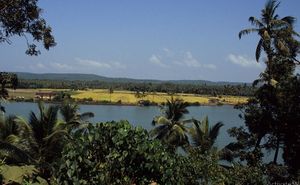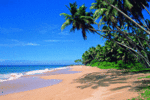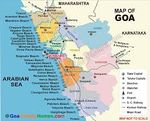Green Infrastructure 2014 Group N - Case Study 4
---> back to group page working group N
Querim-Tiracol River, Goa, India
| Name | Querim-Tiracol | |
| Country | India | |
| City | Tiracol, Goa | |
| Authors | Elena Mihai | |

| ||
|
| ||
Rationale: Why is this case interesting?
This site is located in one of the most spectacular and picturesque areas of India, where jungle vegetation is abundant and the presence of water makes it a facile and foreseeable green infrastructure potential site. The presence of water, history, greenery, wildlife on one hand and the challenges given by a rising economy, growing population and the purpose of preserving world heritage vestiges, this is what makes this site so much interesting. What needs to be considered in analyzing this case is the seasonal movement of waters during the monsoon season, the existence of the Tiracol fort river, the areas that become flood plains during the monsoon, the mitigation of human life with the nature.
Author's perspective
what is your professional/educational background and your relation to the site? I had studied Urban Planning at University of Architecture and Urban Planning Ion Mincu, Bucharest and I also hold a degree in Landscape Architecture from the same University. Now even though I am Romanian, I am analyzing a site from India, because this is the place where I got married with my husband and this is also the place where I have the family. It is as personal as it gets. I've spent here some time and I'm no longer a foreigner to the place.
Landscape and/or urban context of your case
- Biogeography, cultural features, overall character, history and dynamics
- Biogeography
The state of Goa is located between Latitudes 15 degrees, 48'00" N and between 14 degrees, 53'54" N and Longitudes 74degrees, 20'13" E and 73 degrees 40" 33" E. It is 1,022 meters above sea-level.
Goa is bounded on the north by Sindhudurg district of Maharastra state, on the West by the Arabian sea, on the South by Karwar district of Karnataka state and on the East by Belgaum district of Karnataka state The highest mountain is Sonsogor in the Sahyadri range of the Western Ghats which is 3,827 feet.
The Goan landscape is bisected by two major rivers that open into the arabian sea; they are a) The Zuari which is approximately 39 miles and b) The Mandovi which is approximately 38.5 miles. The other major rivers include the Tiracol, Chapora, Sal and the Talpona rivers. All the rivers originate in the Sayhadri ranges and flow westward into the Arabian sea and are navigable throughout the year. Overall Goa's inland waterways are about 250kms.
The state of Goa is the 25th state of the Union Union and has a legislative assembly with a strength of 40 elected members. Goa also has 3 elected members to the Parliament in New Delhi. The Governor is the official head of state and is appointed by the President of India. The Chief Minister heads the council of ministers and is democratically elected and forms the government and is responsible for policies of the government during his reign.
For administrative purposes Goa is divided into two districts- North Goa and South Goa with headquarters at Panaji and Margao respectively together with six divisions and a further sub-divided into 11-talukas, which are as follows:Ilhas, Bardez, Salcette, Ponda, Mormugao, Bicholim, Sattari, Pernem, Quepem, Sanguem, Canacona.The Talukas comprise of towns and villages, most of which have their own governing body-the Panchayat. Some towns also have municipal councils. The most recent statistics put the total number of villages in Goa to be 383 with a total of of 188 village panchayats. There are 31 towns with about 14 municipal councils.
- HYSTORY
In the old times the place carried the name "Gomantak", a word with many meanings mainly meaning fertile land. " however, it is the Portuguese who gave Goa its name. Before they arrived on the scene, Goa, or Gove or Gowapura, was the name only of the port town near the mouth of the Mandovi River. This was also the same site on which the Portuguese later built their capital, today's Old Goa." (refference). The history of Goa has a part of legend about the High Priests(Brahmins) that were eating fish (they were a sect among other Brahmins who are purely vegetarian). Even nowadays the people of Goa like to have fish on their plates every day and people selling fresh fish can be seen all around. The legend says that these priests were called Saraswats because of their origin place, the river of Saraswat, which later on dried, forcing these Brahmins to look for a new place and so they went to the banks of Konkan.
- Culture
Despite successive onslaughts and the ravages of alien occupation, Goa’s cultural traditions have displayed amazing resilience with stimulation by every fresh challenge. To a large extent, Goa’s cultural heritage was enriched by a slow but unremitting process of absorption and assimilation of the more congenial features of this alien culture. The focal point being the symbiosis of Latin and local cultural strains. A Goan is said to be born with music in his blood and music literally accompanies him from the cradle to the grave. Musical traditions run in whole generations. Music itself runs the entire gamut of sonic versatility; from the rustic Dhangar ( Shepherd ) playing and flutes to sophisticated tabla and sitar or violin and piano soloist thrilling large audiences in concert halls. Music is the time seller at all major social events-feasts, festivals, “zatras”, and marriages.
Goan folk music has a lively rhythm and the folk-dances a rugged vitality. The musical accompaniment for both folk songs and the folk dances is provided by a diversity of musical instruments – Ghumats, Dhols, Cymbals (Drums), Flutes, Harmonium, Violins and Guitars. The favorite, however, seems to be the Ghumat. No description in writing can ever do full justice to these dynamic folk art forms. Watching a live performance can elicit to a certain degree its emotional content, rhythmic charm, the colorful variety and vitality.
Freedom brought about a cultural renaissance in Goa along with providing a fresh impetus to the classic literature and fine arts and a revival of the folk arts. Once again the almost forgotten folk dances Dhalo, Fugdi, Corridinho, Mando and performing folk arts (like Khell-Tiatro), Jagar-perani and many others have come out into their own. Indeed the folk music and folk dances have crossed the borders of the state and become popular in the rest of the country during the past 25 years.
- Illustrations: maps; sketches; short descriptive analyses
- Illustrations
- Yourimage.jpg
your visual
Analytical drawings
- Please use analytical drawing for visualising the conflicts/potentials of your site
- Analytical Drawings
- Your drawing.jpg
your drawing
- Your drawing.jpg
your drawing
- Your drawing.jpg
your drawing
- Your drawing.jpg
your drawing
Green Infrastructure benefits for this site
Look again at the multiple benefits of green infrastructure - what could be achieved in your site and which are most relevant?
- Community safety and enjoyement
Traditional infrastructure isn’t designed to handle the increased floods and droughts that come with global warming, so we need a modern approach to protect public health, safety, and quality of life. Green solutions give communities the security and flexibility they need.
- Economy and jobs
These green solutions create good jobs in many sectors, including plumbing, landscaping, engineering, building, and design. Green infrastructure also supports supply chains and the jobs connected with manufacturing of materials including roof membranes, rainwater harvesting systems, and permeable pavement.
- Quality of life
- Technology
We are at a crossroads today in how we manage our water. Traditional water infrastructure will continue to play a role, but it is static, solves only a single problem, and requires a huge expense to build and maintain. We must use this transformational moment to move from old 19th Century infrastructure to a wiser combination of green and traditional infrastructure that will meet the needs of the 21st Century.
Potential for multifunctionality
Green infrastructure has typically multiple functions. What could be achieved for your site in this respect?
Projective drawings
- How would you like this case to change in the near future? (in 1-2 years)
- you may add a short explanation here
- And how could it look like in 10-15 years?
- you may add a short explanation here
- Projective Drawings
- Yourdrawing.jpg
projective drawing
- Yourdrawing.jpg
projective drawing
- Yourdrawing.jpg
projective drawing
- Yourdrawing.jpg
projective drawing
Summary and conclusion
- Goa is a special place. So alive. So vibrant. Some of its sites are so deep rooted in the history, some others are developing outrageously fast. Its challenge remains to keep what it's known for: its beaches, its culture, its river, the forests, the jungle, the style. Green infrastructure has its place here to help preserve the natural paradise and improve the quality of life of the people in villages and cities, as in any emergent economy environment tends to be threatened by the fast pace development and people need to be caring and sensitive towards nature.
Image Gallery
Please add further images/photos here
- Image Gallery
References
- please add your references here
- http://goacentral.com/Goahistory/Historyofgoa.htm
- http://www.americanrivers.org/initiatives/pollution/green-infrastructure/what-is-green-infrastructure/#sthash.MDXWJ1YH.dpuf
About categories: You can add more categories with this tag: "", add your categories









